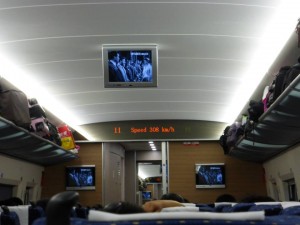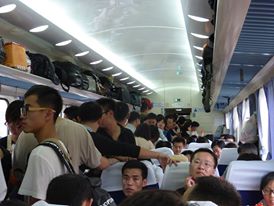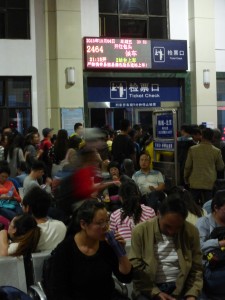
Our first Chinese train ride experience was a G (fast train) to the northern beach town of Qingdao (a side note, we found the town disappointing. Billed as one of the cleanest beach towns in China, we found it to be dirty compared to European and American equivalents, and we never spotted the famous facekini. In fact, the only woman in a swimsuit over the three days we visited was still wearing jean shorts). The town was built largely by the Germans prior to World War I when the Japanese took over for their first of two stints.
During the ride there, we learned that most Chinese train passengers don’t feel a need to wear headphones while entertaining themselves. Our train car in a second class passenger seat was, therefore, like sitting down in a Best Buy showroom for five to six hours at 308 km/hour with a surrounding cacophonous of murderous Japanese schoolgirls screaming, stolid American Army generals yelling and tortured Spanish teens begging under an overhead repeat every two hours of a dubbed-Chinese Roman Holiday starring Gregory Peck and Audrey Hepburn.
We found our next ride, a first class ride on a similar train to Beijing, to be a bit more relaxing with plusher seats and a mostly quieter car. However, our Chinese National Holiday travels would soon introduce us to the full gamut of Chinese train riding experiences as many options sellout seconds after being introduced to hundreds of millions of Chinese travelers.
Catching a few zzz during train travel in China
Our next train ride was an overnight ride on what is known in China as a “soft sleeper.” This is basically equivalent to a first class sleeping car. Four beds are enclosed in each room with doors that shut and allow for privacy, assuming you know the other three people. Otherwise, it’s a bit like hostel accommodations. The beds were more comfortable, lent more space than Navy sailors are given, and serve their purpose for getting a night’s sleep en route to your next destination.
On another overnight train ride, we downgraded slightly to a “hard sleeper” or second class sleeping car. These cars have six beds to a room, offering less privacy and luggage storage capacity without a closing door. We had read horror stories of seemingly privileged middle to upper class Chinese travelers smoking at the end of your bed or sitting on your bed while you attempted to rest, but we did not experience any unpleasantness.
Beware the hard seats

Our final holiday train ride was one that we wished we could have avoided. With our holiday concluding and time for me to return to work, no sleeper cars were available for the final few days. Our agent told us that they sold out in 20 seconds or less. Therefore, we were forced to endure a “hard seat,” basically a second class seat on a lower tier train with no letter preceding the train number. This wasn’t the second class that we experienced en route to Qingdao on a G train. This was basically a bench draped with a blue cloth in rows of three people facing other rows of three people with a small table in between to heap your trash upon while enduring a slow meandering train for 20 hours on a crowded, sometimes cold, sometimes hot, car that apparently also sells standing-room only tickets. With the train car packed to capacity, a food cart still found its way through the aisle every ten minutes for most of the ride as standing-room passengers folded up their small chairs and compressed toward our benches. Our advice: do whatever you have to do to avoid “hard seats!”
The bathroom on the trains are generally a Turkish style hole found in a room at the upper corner of each car, which helps naturally fertilize the crops in passing farms as you travel. If you’ve just arrived in China and fear food indigestion, maybe flying is a better option.
Purchasing train travel in China

We often utilize DIYTravel, a travel agency of an Australian couple experienced in the Chinese transportation industry. For 10 Australian dollars, they can customize your trip and advise you based on the idiosyncrasies of Chinese transportation. For example, when we wanted to go from the small town of Pingyao to Xi’an, knowing that tickets would be very limited and sold out on that route, they advised us to purchase a sleeper ticket on to another city, a much easier ticket to procure for a few extra dollars. They also include Chinese translations to hand over to taxi drivers, ticket distributors and train conductors for each situation you will likely face. They also accept Paypal, allowing you to use your Western credit card. Don’t expect to use it often in China.
Whenever purchasing tickets, pay attention to the train number and particularly to the preceding letter. From our experiences, the G is best. As you downgrade, you may not have individual outlets, elbow room or air conditioning. However, having no individual outlets will at times lead to a quieter environment as your fellow passengers’ electronics will die sooner. Unfortunately, with extended battery life devices continuing to hit the market, that advantage will soon be eliminated, adding to the potential hell of a Chinese train ride.
Basic Guide to Train Numbers when Booking
C = intercity, very limited routes
D = over 200 km/hr, runs main routes
G = fast train, high quality, 308 km/hr along most sections of track
K = “fast train,” lower quality and not as fast as the G, 120 km/hr
L = temporary substitute train, no set schedule, subject to delays and availability
T = “express train,” usually only stopping in major cities, 120 km/hr
No letter = slower trains with many stops and crowds, if the first number is 5 or higher, it probably doesn’t have air conditioning
Several friends have told us detailed stories about traveling amongst pigs and other animals in Korea. On our most crowded train rides, we haven’t yet experienced anything close to this. What’s your “most interesting” travel experience?
-Chris
